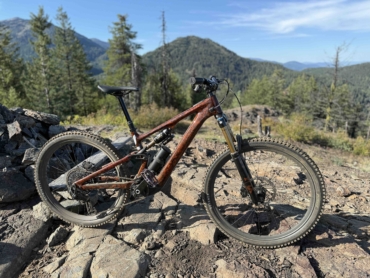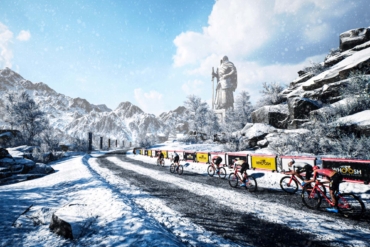Yeti Cycles released the SB160 today, and our rides proved it’s a refined big-travel bike that descends like a demon and pedals with ease.
Except for e-bikes, most 2022-2023 bike brands aren’t showcasing significant, splashy innovations. Yeti Cycles conforms to this trend with the new SB160, fine-tuning its race-winning tech. The brand took a great bike and improved it in previously unimaginable ways. The cumulative changes make the SB160 not just a little better than the awesome SB150 but a bike that’s worth investing in.
“When we launched the SB130 and SB150 over 4 years ago, we pushed the envelope on geometry, kinematics, and ride quality,” said Chris Conroy, president and co-owner of Yeti Cycles.
“Those bikes stood the test of time, but we knew we could make them better and make them faster. Our goal was to improve an already great platform by updating the kinematics, chasing down every detail to make the bikes faster, smoother, quieter, and easier to service. Each small detail was considered. Taken in aggregate, they make a massive difference in ride quality and make the SB160 the best bike we’ve ever made.”

The pandemic and the ensuing shortage of bike parts, bikes, and anything related to cycling were a giant inconvenience for riders who needed to keep trusty steeds running. It was also tough for cyclists hoping to upgrade. Being able to buy the new mountain bike you wanted was as rare as sighting a yeti — the hairy one made of flesh and blood — wandering in the woods.
There were benefits of the pandemic for bike companies, however. New bike releases were largely put on hold, with inventory at an all-time low. Manufacturers couldn’t source parts to complete bike builds.
So brands had the opportunity to take a breath, pause the frantic pace of releases, and take the time to perfect new bikes. And the SB160 is a result of this slower development pace.
The Ride

I had the opportunity to ride the SB160 Turq T3 build in Breckenridge, Colo., with the Yeti team. I also hammered it in France and Italy as a participant in the 6-day Stone King Rally ride.
Some days on the Stone King Rally, I climbed an intimidating 6,500 feet. I didn’t want to do this on any other 160mm/170mm-travel bike. And every day, I descended 10,000 to 14,000 feet.
Yeti’s SB160 was an outstanding tool for the job. The bike was superbly balanced, handled perfectly, and did everything well. I never wished for a smaller or lighter bike. On my home trails in Vermont, I had just as much fun, hucking jump lines and ripping old-school trails.
There are a lot of bikes that descend well, but the SB160 climbed and descended better than any other bike. Pedaling uphill on the SB150 was never bad, but the SB160 climbed better somehow. The Fox Factory Float X2 shock and 38 GRIP 2/170mm fork were a dynamic and supportive duo. They transitioned from stiff on the uphills and plush on the downhills without fiddling with lockouts. The SB160 felt light going uphill. Massive climbs I considered well above my pay grade seemed to melt away.
And there’s little weight penalty for the increased suspension. My size medium SB150 frame weighs half a pound less than the SB160 frame. The medium Turq 3 SB160 with AXS test bike weighs a verified 33.3 pounds.
Also of note, Yeti Cycles now ovalizes the SB160‘s tubes, which stiffened up the ride. It wasn’t jarring; the bike just felt more responsive and easier to control.
Yeti put the ride first when it came to tire selection. The brand could have saved ounces with lighter tires, but it equipped this bike with tires meant for the terrain appropriate for a long-travel rig. Maxxis Assegai 2.5 Exo+ up front and Maxxis Minion II 2.4 Exo+ in the back gripped slimy roots, algae-covered rocks, and dry, sandy, rocky terrain.
Despite hard riding through the Maritime Alps’ dagger-like rock gardens that punctured other riders’ rubber, I never flatted.

On descents, whether they were 1,000 feet on my home trails or 14,000 feet into tiny Italian mountain villages, I felt like I had more control and more “Yeti magic” than ever before.
During the Stone King Rally, which was remote and highly technical, I rolled through heart-stopping downhills with such secure handling that I pushed my mental limits and rode lines I hadn’t thought capable of in the past. On plunging, rocky-tech sidehills, I felt calm and confident.
The brakes were a factor too. Yeti specs a massive 220mm front rotor, 200mm rear rotor, and four-piston SRAM Code RSC brakes on the SB160. These gave me total control on the most harrowing descents and functioned without issue on 10,000-14,000-foot descents for 6 consecutive days.
Parts and Pieces

Looking at the SB160 frame, the most notable change is its higher-clearance downtube, which comes with an extended dual-density downtube protector. Where the SB150 downtube has a squared-off shape, the SB160 downtube has a rounder profile.
A hard-capped rubber under-guard cushions and deflects impacts. The dual-layer guard is replaceable if you smash it. And the hard cap comes off to make dropper post cable routing easier.

The seat tube is also shorter, so I ran a longer dropper post, which gave me more control in slippery, technical terrain. I ride a size M, and I usually run a 150mm max length dropper. On the SB160 in M, I ran a 175mm dropper. That gave me notable extra space to move my bike underneath me.
Yeti says that most riders on small frames will be able to use 150mm dropper posts, medium-frame riders should be able to run a 175mm dropper, and L- to XXL-frame riders should be able to run 200mm-plus dropper posts depending on their seat height.

The bike was remarkably silent on the trail, partly due to the fully enclosed internal cable management. Additionally, my test bike had an electronic AXS rear derailleur. There was no rattle when I was hammering down stair-stepped rocks in the French Alps. And there were no creaks thanks to a threaded bottom bracket, which Yeti says is also cleaner, more durable, and easier to service.
Yeti’s first-gen Switch Infinity had issues that the brand subsequently fixed. The SB160 uses a new, beefed-up Switch Infinity assembly on the T-Series SB160s. It’s also easier to service with improved seals, bearings, and hardware. With more than 30 days on this bike so far, I’ve had no issues.
Another upgrade from the SB150 is redesigned pivots. The SB160 has standard-sized cartridge bearings secured with precision-machined floating collet axles. The bearings are pressed into the linkage assembly, not the swingarm or front triangle. Yeti says this will improve longevity and provide perfect alignment for a smooth ride.

Yeti Cycles uses a patented, two-piece wishbone shock extender for optimal clamping, shock compatibility, and easy shock removal. The shock extender optimizes the SB160’s leverage rate (17%) and pushes the shock forward in the frame.
That has a lot of benefits. You can run a coil shock if you want. It also reduces the standover height. So the SB160, which Yeti Cycles offers in S-XXL, will fit more people. It also leaves more space for a water bottle and gives the bike more downtube clearance.
Yeti Cycles SB160: Downhill Capable
Yeti’s DNA is racing, and it built the SB160 to handle whatever Ritchie Rude and Yeti’s other athletes can put it through. It’s downhill tested, which means that, in addition to a coil shock, you can run a double crown fork to smash the lift serve.
And it comes with a Universal Derailleur Hanger (UDH). If your derailleur hanger gets whacked, it gives you the best chance of getting your hands on a new one ASAP.

The price is the only thing that’s truly tough to swallow. Post-pandemic, prices are soaring in all categories, including bikes. The C-Series carbon, Yeti’s more basic carbon-frame build, starts at $6,100. C-Series bikes do not have the new Switch Infinity.
Turq builds using Yeti’s premium carbon begin at $9,100. I rode the Turq T3 build with AXS, which costs $10,500.

If you love the Yeti Cycles SB150, this bike will blow your mind. If you dream of a bike that can descend anything you point your wheel at, that climbs just as well, you just found it. Bicycles are available at some dealers, though most inventory will arrive in shops in the spring. The SB150 will be discontinued.
The SB160 is available in S-XXL in Turquoise, Cobalt, and Radium.
Check Price at Yeti Cycles







